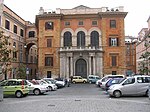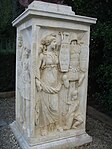Santi Apostoli, Rome
6th-century churchesAll accuracy disputesBasilica churches in RomeBurial places of popesChurches of Rome (rione Trevi) ... and 2 more
Titular churchesTombs of apostles

Santi Dodici Apostoli (Church of the Twelve Holy Apostles; Latin: SS. Duodecim Apostolorum), commonly known simply as Santi Apostoli, is a 6th-century Roman Catholic parish and titular church and minor basilica in Rome, Italy, dedicated originally to St. James and St. Philip, whose remains are kept here, and later to all Apostles. Today, the basilica is under the care of the Conventual Franciscans, whose headquarters in Rome is in the adjacent building. The Cardinal Priest of the Titulus XII Apostolorum is Angelo Scola. Among the previous Cardinal Priests are Pope Clement XIV, whose tomb by Canova is in the basilica, and Henry Benedict Stuart.
Excerpt from the Wikipedia article Santi Apostoli, Rome (License: CC BY-SA 3.0, Authors, Images).Santi Apostoli, Rome
Piazza dei Santi Apostoli, Rome Municipio Roma I
Geographical coordinates (GPS) Address External links Nearby Places Show on map
Geographical coordinates (GPS)
| Latitude | Longitude |
|---|---|
| N 41.898105555556 ° | E 12.483205555556 ° |
Address
Basilica dei Santi XII Apostoli (Parrocchia SS. XII Apostoli)
Piazza dei Santi Apostoli
00187 Rome, Municipio Roma I
Lazio, Italy
Open on Google Maps









